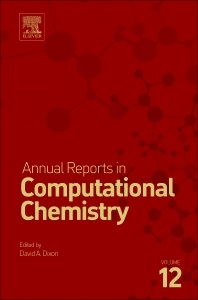Description
Annual Reports in Computational Chemistry
Annual Reports in Computational Chemistry Series
Language: English
Subjects for Annual Reports in Computational Chemistry:
Keywords
3c-4e bonds; Ab initio; Basis sets; ccCA; Coarse-grained simulation; Composite methods; Composite; Continuum modeling; Correlated molecular orbital theory; Coupled cluster theory; Dissipative particle dynamics; Electronic structure; First row anomaly; Generalized Valence Bond; Harmonic vibrational frequencies; High accuracy; Hybrid orbitals; Isotope exchange equilibria; Isotope fractionation factors; Molecular dynamics; Nanoparticle-membrane interactions; Paleoclimate; Recoupled pair bond dyads; Recoupled pair bonds; Reduced partition function ratio; Second-order Møller-Plesset theory; Spectroscopic properties; Thermochemical; Thermochemistry; Valence; Zero point energy
Support: Print on demand
Description
/li>Contents
/li>Readership
/li>Biography
/li>Comment
/li>
Annual Reports in Computational Chemistry provides timely and critical reviews of important topics in computational chemistry as applied to all chemical disciplines. Topics covered include quantum chemistry, molecular mechanics, force fields, chemical education, and applications in academic and industrial settings. Focusing on the most recent literature and advances in the field, each article covers a specific topic of importance to computational chemists.
Quantum Chemistry (Section A) 1. Prediction of Thermochemical Properties Across the Periodic Table: A Review of Correlation Consistent Composite Approach (ccCA) Strategies and Applications Charles Peterson, Deborah A. Penchoff and Angela K. Wilson 2. The Impact of Larger Basis Sets and Explicitly Correlated Coupled Cluster Theory on the Feller–Peterson–Dixon Composite Method David Feller, Kirk A. Peterson and David A. Dixon
New Theories of Bonding (Section B) 3. Recoupled Pair Bonding: Unifying the Theory of Valence for the Main Group Elements Thom H. Dunning, Jr., David E. Woon, Lu. T. Xu, Tyler Y. Takeshita, Beth A. Lindquist and Jeff Leiding
Geochemistry (Section C) 4. Computational Isotope Geochemistry James R. Rustad
Nanoparticles (Section D) 5. Computer Simulation and Modeling Techniques in the Study of Nanoparticle–Membrane Interactions Zhenpeng Ge and Yi Wang
- Includes timely discussions on quantum chemistry and molecular mechanics
- Covers force fields, chemical education, and more
- Presents the latest in chemical education and applications in both academic and industrial settings




